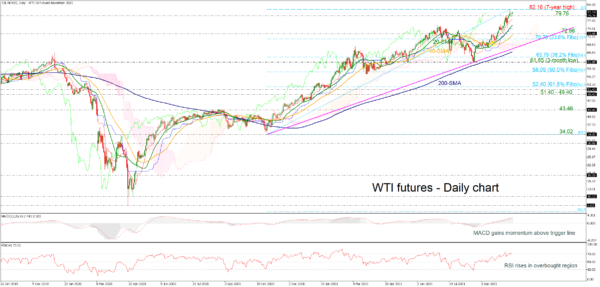WTI crude oil futures are continuing the upside structure, standing around the seven-year high of 82.16. The price has been in a strong bullish pattern since November 2020, trading well above the rising trend line and the simple moving averages (SMAs).
Regarding the technical indicators, the MACD oscillator is moving above its trigger and zero lines, gaining momentum, while the RSI is hovering in the overbought region, suggesting the end of the bullish movement and the start of a bearish correction in the near term. Moreover, the red Tenkan-sen line remains above the flat blue Kijun-sen line and the Ichimoku cloud.
If there is a strong push, the price will rise to the April 2013 swing low of 86.39 should the wall around 82.16 crumbles. If the price rises from here, it may take a rest at the September 2014 high of 94.90.
However, if downward forces return, then the 79.76 support and the red Tenkan-sen line at 78.54 may resume their supportive roles. If the market heads south, it might lead to a faster slide towards the 20-day simple moving average (SMA) at 76.13, which lies ahead of the 72.86 level. Lower prices would erode investor confidence in the long-term upward trend even further.
In brief, a downside reversal is more likely now that WTI oil futures are trading near a key long-term resistance region, although the technical picture is still supportive.













